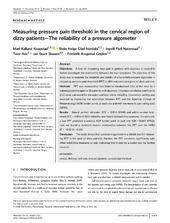| dc.contributor.author | Knapstad, Mari Kalland | en_US |
| dc.contributor.author | Nordahl, Stein Helge | en_US |
| dc.contributor.author | Naterstad, Ingvill Fjell | en_US |
| dc.contributor.author | Ask, Tove | en_US |
| dc.contributor.author | Skouen, Jan Sture | en_US |
| dc.contributor.author | Goplen, Frederik Kragerud | en_US |
| dc.date.accessioned | 2020-08-11T09:21:21Z | |
| dc.date.available | 2020-08-11T09:21:21Z | |
| dc.date.issued | 2018 | |
| dc.Published | Knapstad MK, Nordahl SHG, Naterstad IF, Ask T, Skouen Skouen JS, Goplen F. Measuring pressure pain threshold in the cervical region of dizzy patients-The reliability of a pressure algometer. Physiotherapy Research International. 2018;23(4):e1736 | eng |
| dc.identifier.issn | 1358-2267 | |
| dc.identifier.issn | 1471-2865 | |
| dc.identifier.uri | https://hdl.handle.net/1956/23643 | |
| dc.description.abstract | Objectives: A tool for measuring neck pain in patients with dizziness is needed to further investigate the relationship between the two symptoms. The objective of this study was to examine the reliability and validity of a hand‐held pressure algometer in measuring pressure pain threshold (PPT) in different cervical regions of dizzy patients. Methods: PPT was measured at two bilateral standardized sites of the neck by a trained physiotherapist in 50 patients with dizziness. Intraclass correlation coefficients (ICC) were calculated for intrarater and test–retest reliability. Concurrent validity was assessed by measuring the association between PPT and the American College of Rheumatology (ACR) tender points at each site and with the numeric pain rating scale (NPRS). Results: Almost perfect intrarater (ICC = 0.815–0.940) and within‐session test–retest (ICC = 0.854–0.906) reliability was found between the measures. On each site, a low PPT predicted a positive ACR tender point at each site (OR = 0.864–0.922). Last, we found a statistical inverse relationship between the PPT and the NPRS (R = −0.52 to −0.66). Conclusion: The study shows that a pressure algometer is a reliable tool for measuring PPT in the neck of dizzy patients. Further, the PPT correlates significantly with other subjective measures of pain indicating that it may be a useful tool for further research. | en_US |
| dc.language.iso | eng | eng |
| dc.publisher | Wiley | eng |
| dc.rights | Attribution CC BY | eng |
| dc.rights.uri | http://creativecommons.org/licenses/by/4.0 | eng |
| dc.title | Measuring pressure pain threshold in the cervical region of dizzy patients-The reliability of a pressure algometer | en_US |
| dc.type | Peer reviewed | |
| dc.type | Journal article | |
| dc.date.updated | 2020-01-17T06:11:11Z | |
| dc.description.version | publishedVersion | en_US |
| dc.rights.holder | Copyright 2018 The Author(s) | |
| dc.identifier.doi | https://doi.org/10.1002/pri.1736 | |
| dc.identifier.cristin | 1614729 | |
| dc.source.journal | Physiotherapy Research International | |

